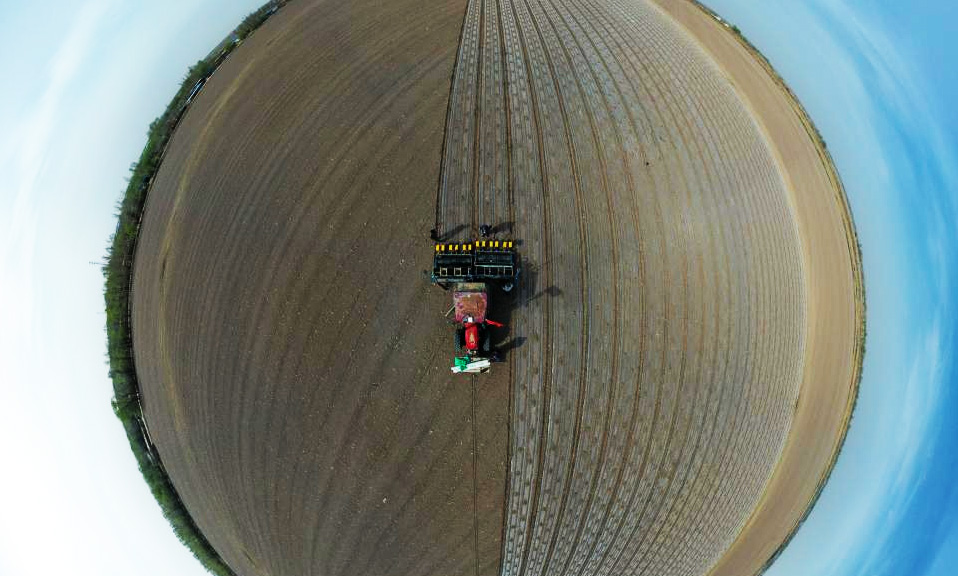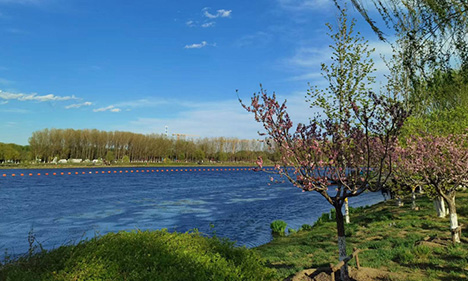World Insights: Blood, tears, discrimination -- the past and present of Japan's Ainu people
TOKYO, April 22 (Xinhua) -- At the southernmost tip of the Oshima Hanto peninsula in Hokkaido, Japan, stands a Matsumae fortress which served as the base of the Matsumae vassal that ruled the area in the Edo Period (1603-1867).
Near the fortress lies a "tomb of ears" made of three prominent black stones. A sign beside the tomb explains its origin: the Ainu people, the indigenous people living in Hokkaido, fought against the brutal rule of the Matsumae vassal but failed in 1669. The ears of the Ainu leaders were severed by the Matsumae vassal and buried in this tomb.
The "tomb of ears" sheds light on the struggle of the Ainu people in Hokkaido against the oppression of the non-Ainu Japanese in ancient times.
OPPRESSED LIVING SPACE
The Ainu people are believed to have lived across the northern Japanese archipelago, with their own distinct language and culture. But as the non-Ainu Japanese moved northward, Ainu territory became increasingly compressed.
By the Edo Period, the non-Ainu Japanese had advanced to the southern part of Hokkaido, though the Ainu people still had some living space in the region.
Since the Meiji Restoration in the late 1860s, the Japanese government developed Hokkaido. The Ainu people suffered unprecedented oppression during that process. Many experts said the history of modern Hokkaido development is a history of Ainu blood and tears.
Gyo Shinya, a Japanese historian of Ainu resistance, said that the Meiji government's policy comprised two parts. One was taking away the Ainu people's land and declaring Hokkaido as terra nullius, allowing the government to nationalize all the land and sell it to the non-Ainu Japanese at low prices.
Second, Ainu traditional customs were prohibited. The Ainu were not allowed to hunt in their customary fashion, and their children were given an "imperial education."
Masahiro Koizumi, a member of a citizens' council on Ainu policy, said the deprivation of the Ainu language alone constituted a human rights violation. The Ainu were banned from hunting and fishing and denied the right to make a living.
TILTED PROTECTION POLICY
In 1899, the Meiji government enacted the so-called protection law for the Ainu. But many experts and scholars in Japan said several of the measures, which claimed to protect the Ainu, had instead been used to deprive the Ainu of land, ban Ainu customs, and eliminate the Ainu language, culture and even names in their language.
After the Meiji period, subsequent Japanese governments continued to maintain and enact anti-Ainu policies.
The notorious protection law was not abolished until 1997. In June 2008, Japan officially recognized the Ainu as Hokkaido's indigenous people for the first time, following the international movement to protect indigenous people, especially after the United Nations Declaration on the Rights of Indigenous Peoples was adopted in September 2007.
In July 2020, the Upopoy National Ainu Museum and Park, under the theme of "national symbiosis," opened in southern Hokkaido. The Japanese government described it as a means to preserve Ainu tradition and culture.
However, in a recent visit to the facilities, Xinhua reporters found little mention of the history of blood and tears of the Ainu people during the Meiji era.
"It's just a tourist facility," Yuji Shimizu, an Ainu elder, said in a seminar, adding the museum tells Ainu history from a Japanese perspective without any apology to the Ainu people.
"So how can you talk about symbiosis?" he said.
Last year, the citizens' council on Ainu policy surveyed Ainu people in Hokkaido and elsewhere. The results showed that most Ainu disapprove of the Japanese government's assistance policies, believing that the government has downplayed the dark side of the Meiji era and avoided the most critical issues of indigenous rights.
One respondent wrote that the facilities mainly showcased Ainu culture but ignored the fact that the Ainu people were deprived of their right to live under the Meiji government.
ETHNIC DISCRIMINATION EXISTS
"Ainu" sounds similar to "ah, dog" in Japanese. In March 2021, the Ainu protested against a contestant on a Japanese TV show who was called out for a derogatory use of the term.
Such a case is far from unique in Japan. Shimizu said that he was bullied at school and was called a caveman by other students.
The Japanese government's surveys also showed that discrimination against the Ainu is a persistent problem in Japanese society. According to a national survey by the Cabinet Secretariat in 2016, 72.1 percent of Ainu respondents said they faced discrimination and disparate treatment in various social situations.
Japanese writer Tsunehira Furuya said that the underlying reason for discrimination against the Ainu is that the ordinary Japanese do not believe that they have invaded or persecuted other ethnic groups.
Although Japanese schools today teach students about Ainu culture, they fail to tell the story of oppression and land deprivation. Hence, ordinary Japanese know little about this dark side of history, he added.
In recent years, historical revisionists and conservatives in Japan have been strongly advocating inaccurate historical facts, such as claiming that "the Japanese were gentlemen and the embodiment of justice in history" and "Japan never invaded or discriminated against other nations," which have aggravated discrimination in the country, he said.
Koizumi, from the citizens' council, said the country must adequately address the history of the Ainu.
"Japan has a habit of completely forgetting its history," he said, "and that's not good."
Photos
 Young artist takes up brush to create lifelike paintings expressing mankind and nature’s harmonious co-existence
Young artist takes up brush to create lifelike paintings expressing mankind and nature’s harmonious co-existence Cutton farming in full swing in China's Xinjiang
Cutton farming in full swing in China's Xinjiang Spring scenery along section of Grand Canal in Beijing
Spring scenery along section of Grand Canal in Beijing New faces called up for Chinese national women's volleyball team while Zhu Ting missing
New faces called up for Chinese national women's volleyball team while Zhu Ting missing
Copyright © 2022 People's Daily Online. All Rights Reserved.






